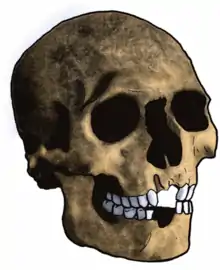Mechta-Afalou
Mechta-Afalou (Mechtoid) or Paleo-Berber are a population that inhabited parts of North Africa during the late Paleolithic and Mesolithic.[1] They are associated with the Iberomaurusian archaeological culture.

Mechtoids are believed to have been assimilated during the Neolithic and early Bronze Age by the makers of the ensuing Capsian culture.[2] Craniometric analysis indicates that these Iberomaurusians were closely related to the early Holocene Capsians of the Maghreb (Tamazgha), as well as the early Holocene Kiffians of the Sahara.[3]
Iberomaurusian fossils excavated at the Afalou site were found to carry the mtDNA haplogroups H or U (3/9; 33%), J (2/9; 22%), H103 (1/9; 11%), H14b1 or JT (1/9; 11%), R0a1a (1/9; 11%), and T2b (1/9; 11%).[4] All of these are Eurasian Haplogroups.
Iberomaurusian fossils excavated at the Ifri N'Ammar site were found to carry the Y-DNA haplogroups E-M35*(1/2; 50%) and E-L19*(1/2; 50%). All individuals carried the mtDNA haplogroup U6.[5]
Iberomaurusian fossils excavated at the Taforalt site were found to carry the Y-DNA haplogroups E-M78*(4/6; 66%), E-L618*(1/6; 16%), and E-M215*(1/6; 16%). All individuals carried the mtDNA haplogroups U6(6/7; 85%) and M1(1/7; 14%).[6]
Loosdrecht et al. (2018) analysed genome-wide data from seven ancient individuals from the Iberomaurusian Grotte des Pigeons site near Taforalt in north-eastern Morocco. The fossils were directly dated to between 15,100 and 13,900 calibrated years before present. The scientists found that all males belonged to haplogroup E1b1b, common among Afroasiatic males. The male specimens with sufficient nuclear DNA preservation belonged to the paternal haplogroup E1b1b1a1 (M78), with one skeleton bearing the E1b1b1a1b1 parent lineage to E-V13, one male specimen belonged to E1b1b (M215*). These Y-DNA clades 24,000[7] years BP had a common ancestor with the Berbers and the E1b1b1b (M123) subhaplogroup that has been observed in skeletal remains belonging to the Epipaleolithic Natufian and Pre-Pottery Neolithic cultures of the Levant. Maternally, the Taforalt remains bore the U6a and M1b mtDNA haplogroups, which are common among modern Afroasiatic-speaking populations in Africa. A two-way admixture scenario using Natufian and modern sub-Saharan samples (including West Africans and the Tanzanian Hadza) as reference populations inferred that the seven Taforalt individuals are best modeled genetically as of 63.5% Natufian-related and 36.5% sub-Saharan ancestry (with the latter having both West African-like and Hadza-like affinities), with no apparent gene flow from the Epigravettian culture of Paleolithic southern Europe. The scientists indicated that further ancient DNA testing at other Iberomaurusian archaeological sites would be necessary to determine whether the Taforalt samples were representative of the broader Iberomaurusian gene pool.[8]
See also
Notes
- Wendorf, Fred; Schild, Romuald (1986-01-01). The Wadi Kubbaniya skeleton: a Late Paleolithic burial from southern Egypt. Southern Methodist University Press. p. 68. ISBN 9780870742163.
- P. Sheppard & D. Lubell (1991). "Early Holocene Maghreb prehistory: an evolutionary approach" (PDF). Sahara. 3: 63–9. Retrieved 4 August 2016.CS1 maint: uses authors parameter (link)
- Sereno PC, Garcea EAA, Jousse H, Stojanowski CM, Saliège J-F, Maga A, et al. (2008). "Lakeside Cemeteries in the Sahara: 5000 Years of Holocene Population and Environmental Change". PLOS ONE. 3 (8): e2995. doi:10.1371/journal.pone.0002995. PMC 2515196. PMID 18701936.
- Kefi, Rym; et al. (2016). "On the origin of Iberomaurusians: new data based on ancient mitochondrial DNA and phylogenetic analysis of Afalou and Taforalt populations". Mitochondrial DNA Part A: 1–11. PMID 28034339.
- Fregel, Rosa; Mendez, Fernado L.; Bokbot, Youssef; Martin-Socas, Dimas; Camalich-Massieu, Maria D.; Santana, Jonathan; Morales, Jacob; Avila-Arcos, Maria C.; Underhill, Peter A. (2018-02-20). "Ancient genomes from North Africa evidence prehistoric migrations to the Maghreb from both the Levant and Europe". bioRxiv: 191569. doi:10.1101/191569.
- Loosdrecht, Marieke van de; Bouzouggar, Abdeljalil; Humphrey, Louise; Posth, Cosimo; Barton, Nick; Aximu-Petri, Ayinuer; Nickel, Birgit; Nagel, Sarah; Talbi, El Hassan (2018-03-15). "Pleistocene North African genomes link Near Eastern and sub-Saharan African human populations". Science. 360 (6388): 548–552. doi:10.1126/science.aar8380. ISSN 0036-8075. PMID 29545507.
- https://yfull.com/tree/E-M35/
- van de Loosdrecht; et al. (2018-03-15). "Pleistocene North African genomes link Near Eastern and sub-Saharan African human populations". Science. 360 (6388): 548–552. doi:10.1126/science.aar8380. ISSN 0036-8075. PMID 29545507.
References
- Physical Anthropology of European Populations, Mouton, 1980.